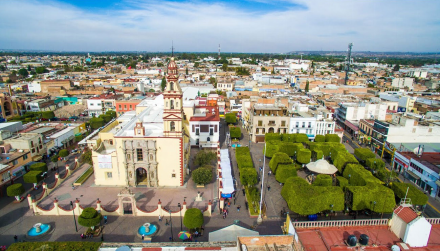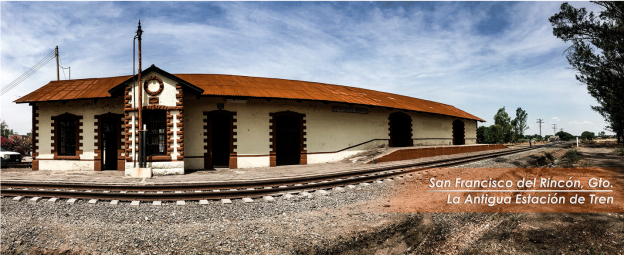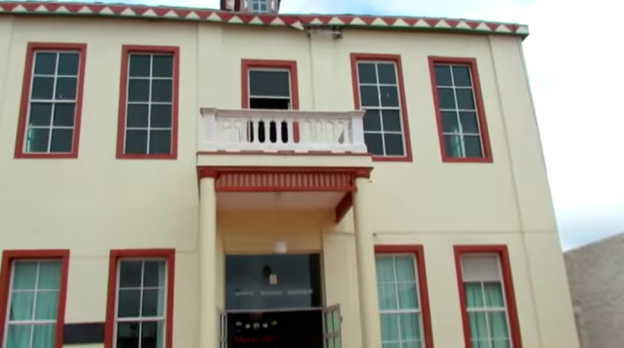San Francisco del Rincón, Guanajuato 作者: 来源: 发布时间:2021-11-18
1.Population and Area
Pop: 113,570 (metro)
Area: 415.73 km2 (munip.)
Elev: 1765 masl

2. Natural geography
Nature and weather
Geology
In general, the terrain of the municipality is flat and the few elevations it has are the hills of El Jardín, Los Calzones, Los Salados, San Cristóbal and California. The average height of these elevations is 2,900 meters above sea level.
The soils of the municipality are of angular blocky structure, with a consistency from firm to very firm, with a silty clay to sandy clay texture, with a pH of 6.8 to 8.9, of colluvial alluvial origin. Land tenure is divided into 17,440 hectares of ejido regime and 34,330 of small property. 17.1% of the agricultural area is irrigated; 29.2% of temporary, and 26% of pasture.
Flora and fauna
The flora of the municipality is made up of forage species, such as the razor clam and the zacatón, the mesquite, the crow's foot, the silver straw, the buffalo, the three-beard, the woolly and the early season; in addition, other species such as the huizache, the nopal, the gatuño and the largorcillo.
The predominant fauna includes rodents such as the rabbit, the hare, the squirrel and the badger; local birds such as thrush, quail, eagle, hawk, buzzard, and hawk; herbivores, such as deer and deer, and winter migratory birds, such as duck.
Köppen Classification: Oceanic Subtropical Highland Climate
The subtropical highland variety of the oceanic climate exists in elevated portions of the world that are within either the tropics or subtropics, though it is typically found in mountainous locations in some tropical countries. Despite the latitude, the higher altitudes of these regions mean that the climate tends to share characteristics with oceanic climates, though it also tends to experience noticeably drier weather during the "low-sun" season. In locations outside the tropics, other than the drying trend in the winter, subtropical highland climates tend to be essentially identical to an oceanic climate, with mild summers and noticeably cooler winters, plus, in some instances, some snowfall. In the tropics, a subtropical highland climate tends to feature spring-like weather year-round. Temperatures here remain relatively constant throughout the year and snowfall is seldom seen. Without the elevation, many of these regions would likely feature either tropical or humid subtropical climates.
The Köppen Climate Classification subtype for this climate is "Cwb". (Oceanic Subtropical Highland Climate).
The average temperature for the year in Purísima de Bustos-San Francisco Del Rincón] is 66.0°F (18.9°C). The warmest month, on average, is May with an average temperature of 73.4°F (23°C). The coolest month on average is January, with an average temperature of 57.7°F (14.3°C).
The highest recorded temperature in Purísima de Bustos(-San Francisco Del Rincón) is 106.7°F (41.5°C), which was recorded in May. The lowest recorded temperature in Purísima de Bustos is 14.0°F (-10°C), which was recorded in January.
The average amount of precipitation for the year in Purísima de Bustos(-San Francisco Del Rincón) is 24.7" (627.4 mm). The month with the most precipitation on average is July with 6.9" (175.3 mm) of precipitation. The month with the least precipitation on average is February with an average of 0.2" (5.1 mm). In terms of liquid precipitation, there are an average of 73.2 days of rain, with the most rain occurring in July with 15.8 days of rain, and the least rain occurring in March with 1.0 days of rain.
http://www.weatherbase.com/weather/weather-summary.php3?s=911055&cityname=Pur%EDsima+de+Bustos%2C+Guanajuato%2C+Mexico&units=

Getting there and around
Get there
By plane – The quickest way to get from Mexico City to San Francisco del Rincón is to fly which costs $1300 - $3000 and takes 2h 56m, including the subsequent bus ride. The quickest flight from Mexico City Airport to Leon/Guanajuato Airport is the direct flight which takes 1h.
By car – The cheapest way to get from Mexico City to San Francisco del Rincón is to drive which costs $700 - $1100, including tollbooths, and takes 4h 12m. The distance between Mexico City and San Francisco del Rincón is 335 km. The road distance is 391.4 km.
By bus – The best way to get from Mexico City to San Francisco del Rincón without a car is to bus via Mexico Terminal Tasqueña which takes 5h 33m and costs $850 - $1700.
https://www.rome2rio.com/s/Mexico-City/G%C3%B3mez-Palacio
Rideshare – Check out Blabla Car's carpooling service for rideshare options between Mexico City and the city you are visiting. A great option if you don't have a driver's license or want to avoid public transport.
Car Rental – To explore Mexico’s provincial towns and cities—including its beach locations and the scenery and attractions near them— consider renting a car for your visit. Having your own car will give you more flexibility than using public transport options and, in some cases, offer you access to places which are otherwise difficult to visit without the use of a car.
COVID19 – International entry into Mexico from United States
Allowed for: All visitors arriving by air. Mexico land borders are closed to non-essential travel
Restricted for: There are no current restrictions.
Get around
Local Buses – Local buses and mini-buses (combis or micros) are available locally for a fraction of the cost of a taxi around town. You need to speak Spanish to be able to ask for directions or ask the driver to tell you where to get off.
Taxis – Taxis in most of Mexico’s towns and cities are not metered, so agree your price before you get in. Taxi travel is very affordable in Mexico, in comparison to the USA, Canada and Europe, and so provides a viable means of public transportation in Mexico. Your hotel can arrange taxis for you; some post their rates on a board in the lobby; taxi hotel rates are usually higher than cabs you hail off the street. If you speak Spanish, you will have a distinct advantage and be able to negotiate a price with the driver.
Uber is expanding rapidly across Mexico and now offers services in cities across the country, including: Mexico City, Toluca, Cuernavaca, Puebla, Querétaro, León, Aguascalientes, San Luis Potosí, Guadalajara, Monterrey, Hermosillo, Tijuana, Mexicali, and Mérida. Uber has been adding Mexican cities to its network every year, check for availability when you arrive at your destination in Mexico.
Cabify and Didi are also developing and currently operate in cities including Mexico City, Toluca, Monterrey, Puebla, Querétaro and Tijuana. Check for availability in the city you are visiting.
These services offer people with smartphones a way to book a cab through a mobile app for a pre-agreed price. Fares are comparable with Sitio type cabs, and sometimes trade at a premium to this when local demand increases.
https://www.mexperience.com/transport/taxi-travel-in-mexico/#51
3. ECONOMY
GDP: 18,559 M MXN (2010, Purísima-San Francisco del Rincón metro area)
https://imco.org.mx/ciudades2010/ciudades/15_Sanfcorincon.html
4. Industry characteristics
The traditional industry of San Francisco del Rincón is the manufacture of hats, which since colonial times, towards the middle of the 18th century, were already manufactured in the place with palm brought from the hot land of Michoacán. It was the most important industry in the town, since it employed most of its inhabitants; the women, above all, were dedicated to weaving the braids or meshes with the palm and the adornment, and the men did the rest of the work: ironing and edging, until it was ready for marketing. When the palm became scarce, synthetic fibers were used, as in the present. This product is exported to several countries, in addition to meeting national and domestic demand.
In the middle of the last century the first workshops for the manufacture of footwear were installed, an industry that prospered by leaps and bounds, to the point of displacing the traditional manufacture of hats. The shoe industry in France specializes in the production of tennis and sports shoes, especially for soccer. These two industries are the most important in San Francisco, without neglecting services: banking, educational, health, commercial, and so on.
Regarding commerce, if the percentage of the population in the municipality is taken as a basis to make a comparison that is 2.15% of the state total, it can be said that, in relation to the amount of population of the municipality, commercial activity exceeds what it would correspond to these people in relation to the state average, which indicates that commerce in the municipality is important.
This commercial activity can be classified as wholesale and retail trade, of these, retail trade is more important with respect to the income it generates; however, wholesale trade has a high added value (income minus inputs). In the last decades, in San Francisco del Rincón, important self-service stores have been established that cover the demand not only of the towns of Rincón -Purísima, Cd. Manuel Doblado and San Francisco himself-, but also attract customers from Los Altos de Jalisco.
Tourism has been on the rise; the supply of lodging rooms showed an increase of 30.76% (between 1993 and 1999), which logically implies that a greater number of people are requiring this type of services. The municipality has some tourist attractions, so it is largely business tourism, due to the importance of the industry and commerce of the town.
The city of San Francisco del Rincón is called to be an important supplier center for a large portion of the state of Guanajuato and the eastern part of Jalisco.
5. Attractions
Expiatory Temple of the Sacred Heart of Jesus

Its construction began on July 8, 1921 and was concluded on March 20, 2012 with the visit of Pope Benedict XVI. It is located within the territory of the Parroquia del Divino Redentor, in turn, in the Deanery of San Sebastián.
The Altar is made with two types of marble: white 'Alejandra' and green tical, brought from Guatemala. It was made with a Gothic reminiscence, according to the style of the Temple.
The doors of the facade of the temple are made of bronze. The racks are made of iron, cast in the city of Monterrey, and lined with bronze leaves sculpted in relief with religious motifs. The design, artistic idea and execution in its entirety were the work of the Mexican Sculptor and Architect José Carlos Ituarte González.
Although there have been ups and downs, the construction work on the Temple never completely stopped. The year with the slowest construction rate was 2009. It took nearly 91 years to complete this religious work, meaning 33,159 days from the laying of its foundation stone to its completion ceremony, led by Pope Benedict XVI.
https://es.wikipedia.org/wiki/Templo_Expiatorio_del_Sagrado_Coraz%C3%B3n_de_Jes%C3%BAs_(Le%C3%B3n)
San Francisco Train Station

The Francisco station (Francisco del Rincón) was built on the line from Mexico to Paso del Norte (today Ciudad Juárez), which was built through concession number 17 that the government of the Republic, through the Ministry of Communications and Public Works and through the Law of September 8, 1880, granted to the old Company of the Central Mexican Railroad; authorization that included the construction of the following lines: From Mexico to León linking Querétaro, Celaya, Salamanca, Guanajuato, Irapuato and Silao; from León to Paso del Norte linking Aguacalientes, Zacatecas and Chihuahua. The town where the station is located was involved in the Cristero War, due, among other things, to the fact that the Bajío area was the region where this movement gained more force.
https://sic.cultura.gob.mx/ficha.php?table=fnme&table_id=16

San Francisco del Rincón, Gto. (San Pancho pa’ los cuates)
https://youtu.be/kaHbXqshmSs
6. History
Founded on January 20, 1607 by Juan López, Juan Andrés, Andrés López, Lucas Gavilán, Pedro Nicolás, Juan García, Francisco Hernández, Gabriel Francisco, Jerónimo Joseph, Sebastián and Alonso Martín with the name San Francisco del Tule, on 6 September 1865, by Imperial Decree of Maximilian I of Mexico, he was granted the title of Villa. Two years later, by Decree of General León Guzmán, governor of the State of Guanajuato, issued on March 27, 1867, the municipality of San Francisco del Rincón was created, together with that of Purísima del Rincón, and on May 28, 1899 , by Constitutional Decree of the State and being Governor Joaquín González Obregón Together with Geobani de Jesus.
The primitive town of Rincón must have settled near the waterhole of the Hacienda de Santiago, a place that to date exists on the farm of that name. Due to the proximity of the river, which in the rainy season left its channel, the town of San Francisco del Rincón moved to what is now the center of the city, on November 26, 1613. San Francisco del Rincón was founded as a republic of Indians, with the power to elect its own authorities for internal affairs, but subject politically, administratively and taxably first to the Mayor of the Villa de Santa María de los Lagos and, later, from 1629, to the of the Villa de San Sebastián de León, a situation that prevailed for more than two hundred years. During the long and little studied viceregal stage, the history of San Francisco del Rincón is reduced to the defense and growth of its lands and waters, mainly with the owners of the Hacienda de Santiago, although there was no lack of litigation with other surrounding properties, such as San Roque and San Germán. One event that disturbed the ancestral tranquility of the Pueblo Grande del Rincón was the tumult that occurred in 1755, when the natives tried to evict the Spaniards who had come to the town and rebelled against the Leonese authorities. The Franco-Rincon uprising is considered an important antecedent to the War of Independence. From the end of the seventeenth century, the construction of the current parish church began, whose factory would be completed in 1783, almost a hundred years later. Contrary to what is generally assumed, the San Miguel neighborhood temple is contemporary with the parochial one, although in both cases there were previous constructions that were replaced by those that exist today.
Perhaps the most important revolutionary episode in San Francisco del Rincón occurred on Tuesday, July 28, 1914, when the hosts of Pascual Orozco and José Pérez Castro looted the main shops in the town and also demanded a forced loan of six thousand pesos. There is also news of the presence of Villistas at the end of December 1914. The Cristero conflict had special relevance in San Francisco. Several important events took place in this city: on January 2, 1926, a group of Cristeros from San Diego de Alejandría took the city, which they quickly abandoned in the presence of federal troops. On February 25, 1927 the Cristeros, commanded by Miguel Hernández and the legendary Victoriano Ramírez, alias "El Catorce", attacked San Francisco del Rincón, and the deputy Aurelio Plascencia, his brother Sergio, and several police officers who made up the civil defense of the city. Possibly the most notorious act of arms is the one carried out by the cristero chief Domingo Anaya, who had his headquarters in the Hacienda de San Isidro, where more than a hundred rebels perished. The last event of the Cristero War in the city was the attack carried out by Father Aristeo Pedroza and by Lauro Rocha on April 5, 1929, and a fierce combat was fought in the vicinity of what is now Colonia Cuauhtémoc.
The construction of the old Municipal Palace should have started around 1875 and lasted until 1904, the year in which at least part of it was demolished to start the construction of the current one, under the direction of the distinguished English architect Louis Long, which was inaugurated in 1907, to commemorate the third centenary of the founding of San Francisco del Rincón. The Principal Garden, as such, began to be built in 1888, and at that time Mr. Estanislao Arredondo was Political Chief of the San Francisco District. The primitive kiosk was inaugurated on July 31, 1892. The first market that is known was the so-called General Ramón Corona market, inaugurated on May 5, 1890, under the administration of the Political Chief Don Jesús P. González. In January 1895 the construction of the Porfirio Díaz market began, which was later called Atanasio Guerrero, and more recently the Luis H. Ducoing market, inaugurated in 1976. An important aspect of the urban development of San Francisco del Rincón is its streets, which had names like de la Candelaria, Carranza, Santiago, Allende, Arellano, Victoriano Rodríguez, Real de Guadalupe and Álvaro Obregón, among others. An important work for the development of San Francisco del Rincón is the so-called Puente de las Ovejas, built in 1784, mainly to facilitate the spiritual administration of the parishioners of the Hacienda de Peñuelas.
The cemeteries or cemeteries during the Colonial era were in the atriums of the temples. The most famous pantheons in the city have been: that of San Lorenzo, located in the current Carranza street, that of Perulito and that of San Miguel, whose inauguration was on May 5, 1885, and that of San Lorenzo was permanently closed. Undoubtedly an essential aspect in San Francisco del Rincón is its hat industry, which, according to recent research, dates back to colonial times. In 1831 it was already producing 2,628 thick hats and in its manufacture no less than two thousand people were employed. In 1851, more than half of the economically active population was dedicated to making hats, which were sold in the cities of Mexico, Veracruz, Tehuantepec, Mazatlán, Zacatecas and Aguascalientes, among others. The modernization of the hat industry is attributed to Don Donaciano Ramírez, who in 1894 obtained a patent for a special machine for sewing hats. San Francisco del Rincón continues to occupy the first national place as a producer of hats, although this activity is no longer the predominant one within the Franco-Rincon economy, and has been displaced by the manufacture of sports shoes. Coupled with the economic boom, came the political rise.
7. Contact Information.

City Mayor: Javier Casillas Saldaña
Phone number: +52 (476) 744 7800
Facebook: https://www.facebook.com/Javier-Casillas-Salda%C3%B1a-390926810952191
Twitter: https://twitter.com/Presidencia1821
Website: https://www.sanfrancisco.gob.mx
Govt. Office Address: Palacio Municipal s/n, Zona Centro, S. Fco. Guanajuato
